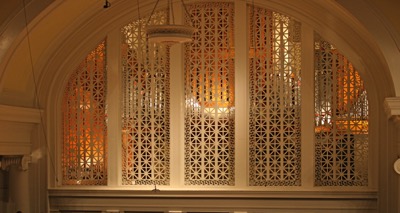Pillars and Glisses was inspired by an experience that I had just after learning of my Wild Rumpus commission. At a new music concert in Chicago I attended, I was struck by a design I saw in the concert hall (pictured above). I observed it—a simple grille covering the organ across the back wall—and was immersed in its simplicity, and more importantly, its implicit motion and systematic structure. I immediately saw the potential translation of the grille design into a musical shape/structure, and I was inspired to create a piece demonstrating this translation.
I have long been interested in alternative approaches to notation including graphic, spatial, time-duration, and modified tablature notations. I have taught courses on alternative notation practices at several universities, and my dissertation focused on areas of this as well. I am particularly drawn to the idea that one piece may involve multiple approaches to notation depending on the specific material’s characteristics. As a user of music notation software in addition to handwriting scores, I frequently find it problematic to notate certain graphic or alternative notations successfully within any one given program. In these cases, I juxtapose hand written sections with partially computer-notated sections. When writing Pillars and Glisses, I began experimenting with new ways to achieve my desired type of notation and found Adobe In Design to be the most useful way of realizing these ideas. This marks an important intersection and culmination of my new explorations in notational, musical, and ideological frontiers.
Program Note
"Pillars and Glisses explores Epstein's preoccupation with the object-like qualities of sound. Epstein conceived the work in emphatically spatial-physical terms, describing it as a “sound-sculpture composition, where material is realized as tactile, space-occupying structure.” As such, rather than working on the level of traditional motivic work and metrical time, Epstein notates the work in terms of the interplay of two paradigmatic sound objects: pillars (notated in the squares as rectangles), which represent brief, loud outbursts of sound at the musicians' registral and timbral extremes; and glisses, in which musicians slide upwards or downwards between pitches. As it constantly oscillates between these basic objects in subtly changing configurations of instruments, the work suggests a mediation between a basic opposition of static suddenness (in the pillars) and gradual transition (in the glisses)." —Etha Williams
Commissioned by Wild Rumpus Ensemble
Premiered June 2012 by Wild Rumpus Ensemble
Live concert recording
ODC Dance Commons
San Francisco, CA

Pillars and Glisses (2012)*
for 2 soprano, flute, clarinet, violin,
cello, electric guitar, piano
